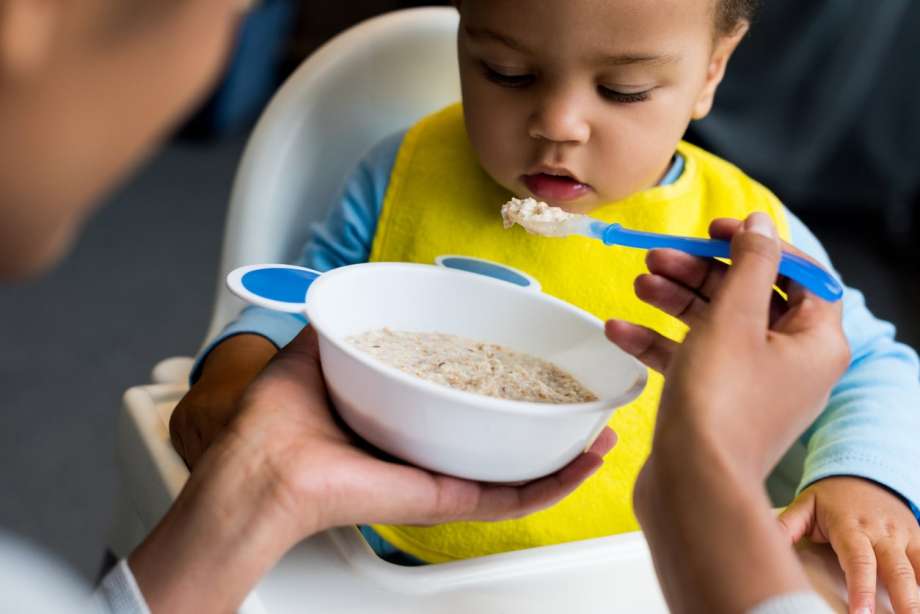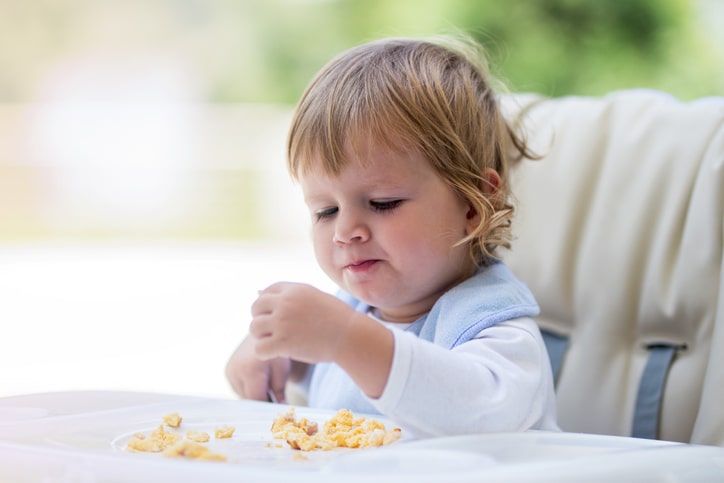When to Introduce Baby Cereal: Baby’s First Foods by Age

As your baby grows older, their nutritional needs change. A baby is either breastfed or formula-fed as a newborn and that is all infants need to grow and thrive.
However, the day will come when your baby will be ready to develop “big kid” eating habits and start eating solids. If this is your first child, this is likely all new to you. So, how do you know when your baby is ready to eat cereal and other solid foods?
Related: The Best Foods for Baby-Led Weaning
Can You Feed Cereal to a Newborn?
No. Babies are typically recommended to wait until at least 4-6 months of age before having something other than breast milk or formula.
There are many reasons you might be tempted to start solids early with infants. You may worry that your baby isn't getting enough from breast milk or formula, but it can be dangerous to introduce solid foods too early to infants.
Risks of Feeding Babies Solids Too Young
Although some grandmothers and neighbors may swear that a little cereal in their newborn's bottle helped him sleep better, recent studies do not support this assumption. Cereal should not be added to the bottle unless instructed by a pediatrician for medical indication, as doing so may increase the risk of choking.
In addition to needing to reach important developmental milestones to safely consume solids/purees, the newborn gut also needs to fully develop, which happens at about 6 months of age.
Introducing foods prior to gut maturity can lead to digestive issues, illnesses, and allergies. Introducing solid foods too early may also increase the risk of obesity and lead to baby-led weaning, decreasing the intake of essential nutrients from breast milk or formula.
- The American Academy of Pediatrics recommends only breastmilk or formula until about four to six months of age.
- After introducing solid foods, continue providing breastmilk and/or formula until at least 1 year of age.
- Consuming breast milk is recommended for babies and toddlers for 2+ years.
Related: From Birth to Four Months: Dietary Milestone
When to Start Solids/Purees (4-6 Months)

Readiness for solid foods varies from baby to baby. Once your infant is between four and six months of age, they may start showing signs of readiness for soft solid foods like purees.
These signs include:
- The ability to support their head
- Good tongue thrust (can push food out of their mouth)
- Showing interest in the foods you're eating
- Brings objects such as toys up to their mouth
- Their birth weight has doubled, or they weigh about 13 pounds
If your baby is not developmentally ready, they will be unable to transfer the food from the front of the mouth to the back, or consistently push the food out of their mouth. You can try diluting the food with breastmilk or formula so it is a thinner consistency, or simply wait for a week or two and try again.
Don’t worry, soon enough you'll be cleaning up pureed peas and carrots and all types of baby food from the kitchen floor. In the meantime, enjoy breastfeeding or formula feeding until they are ready for solid foods.
Related: Is Your Baby Ready for Solid Foods?
When to Introduce Finger Foods (7-9 months)
Finger foods are usually introduced when your baby is between 7-9 months old, when your baby shows signs of development that are needed for safe consumption. Readiness signs include
- Ability to sit up by themselves or with very little assistance
- Demonstrating a chewing motion with pureed foods
- Development of the pincer grasp (able to hold a small object between their thumb and index or middle finger).
Common early finger foods include small pieces of soft foods such as cut-up bananas, scrambled eggs, steamed carrots, well-cooked peas, or finely chopped chicken. All finger foods should be soft, and easy to swallow. Always observe your baby while introducing finger foods. Discuss with your pediatrician when your newborn should be introduced to finger foods.
How to Introduce Your Baby to Solid Foods
When you feel your baby is ready and your pediatrician gives the go-ahead, you start feeding soft foods. While most will first introduce a pureed vegetable or fruit, or infant cereal, food can be introduced in any order.
Iron stores begin to decrease around 6 months, so breastfed newborns especially should be given a food high in iron as one of their first foods. This may be soft meat, which can be pureed, or single-grain cereals that are iron-fortified, such as oat or barley.
Timeline of the Best First Foods for Babies
Introduce new foods one at a time, and always wait a few days before introducing another new food. For example: provide a pureed fruit or vegetable on day one, two, and three, and introduce a new food such as fortified newborn oat cereal on day four. By doing this, you can watch for any diarrhea, bloating, rashes, or other signs of an allergic reaction or intolerance.

Foods should be single-ingredient only, with the exception of fortifications of vitamins or minerals, which are recommended for infant cereals. Breastmilk or formula can be added to the food to provide a familiar flavor and help soften the food. Mashed or pureed foods are generally easier for babies.
Later, babies will transition to thicker or lumpier food consistencies as more oral skills develop. Since infants are just beginning with new tastes and textures, don't be surprised if your baby initially rejects your attempts.
Try again in a few minutes, but never force food to an infant who is not interested. If the child cries or turns away, wait a few days until attempting again.
Start Small and Try a Variety of Foods to Develop Baby’s Tastes
Begin with just one or two teaspoons, and increase gradually. Eventually, the amount of solid foods should be about 4 ounces per meal. Too much solid food will cause a significant decrease in the intake of formula or breastmilk, which provides essential nutrients. It is best to introduce a variety of flavors and textures within the first few months, while the baby is still developing their taste preferences.
Should You Wait to Introduce Seafood or Nuts to Babies?
While anything could be an allergen, common food allergens include: eggs, fish and shellfish, tree nuts, peanuts, wheat, soy, sesame, and cow’s milk. (While cow’s milk is not recommended until 1 year of age, products such as yogurt can be introduced prior to 1 year of age).
Current research does not support waiting an extended period to introduce foods that are common allergens, as this delay in exposure can actually increase the risk of allergy. But these foods should never be introduced prior to 4 months of age.
Instead, it is recommended to first try a few foods that are low risk for allergies, and then begin introducing a potential allergen; with a small amount first, and a gradual increase if no signs of allergy or intolerance are noted.
NOTE: A newborn with eczema or an egg allergy should be tested for a peanut allergy prior to introducing products with peanuts. Always discuss the best way to introduce foods with your pediatrician.
Baby Choking Hazards and Foods to Avoid Giving Infants

Parents should completely avoid giving infants and newborns any food that requires chewing as these are considered choking hazards.
Common Choking Hazards for Infants
- Hot dogs (even if they are cut up)
- Hard fruits or vegetables (including fruit chunks like apple chunks or canned pineapple)
- Popcorn
- Chunks of meat or cheese
- Whole grapes
- Chew candy or hard candies
- Nuts (until age 4 due to risk of aspiration)
- Peanut Butter (unaccompanied) as it can get stuck in a baby’s throat and clog their airway.
Unsafe Foods for Babies Under 1-Year-Old
- Too many rice products: (rice cereal, rice flour, rice puffs, etc). Rice products absorb more arsenic than other grains. Consider barley or oat cereal and other single-grain products to limit exposure to arsenic.
- Honey: Giving honey to babies under age 1 can cause infant botulism. A baby’s digestive system can't handle the natural bacteria in honey.
- Cow's milk: Cow's milk should not be introduced during the first year. Continue with breastmilk or formula until at least 1 year. *Cow milk products such as yogurt can be introduced prior to 1 year.
- Soy Milk: Soy milk is not recommended until 12 months of age
- Fruit juice: Juices and other sugary foods or drinks are not a good choice for your baby. They are not necessary to meet nutritional needs and can cause tooth decay, especially when put into a baby's bottle. Additionally, since fruit juice does not have the fiber that whole fruits have, the juice will cause a sugar spike. Instead, stick to infant formula or breast milk in a sippy cup. TIP: If you introduce juice in the toddler years, consider diluting it with water, and provide less than 4 ounces per day.
- Water: Your infant does not require water. However, if desired, 8 ounces or less can be provided a day in a sippy cup or a cup with a straw.
- Processed Foods: Foods for adults and toddlers are processed and contain higher salt content and preservatives. These should be avoided in infants.
Stool Changes After Starting Baby on New Foods
In addition to more messes to clean up, there will be other changes as your baby begins digesting new foods. Added sugars and fats will make their stools stronger in smell, and they may vary in color.
Green vegetables may turn the stool green, while beets are known to turn stool (and urine) red. Undigested foods or skins of food may be visible in the stool. This is expected and normal as the infant’s digestive system continues maturing.
If stools become watery, loose, or contain mucus, reduce the amount of solid foods. Contact your pediatrician if these stools continue. As you gradually increase the amount of solid foods, the newborn will want and need less formula and/or breast milk.
How to Prepare Baby Food at Home
Buying baby food and snacks can get expensive, so many prefer to also make their own baby food at home. Here are some of our expert tips for making your own baby food with a food processor, baby food maker, or even just regular utensils!
- Consider mixing cereal, grains, or soft foods with breastmilk or formula for a thinner consistency, and familiar taste.
- Vegetables or fruits should be mashed (can use a fork), or pureed/blended.
- Foods that are hard (such as carrots or sweet potatoes) should first be cooked or steamed until they are easily smashed with a fork.
- Remove all pits and any tough skin from foods
- Remove any fat or bones from meat before cooking
- When introducing thicker textures, cut all soft foods into bite-size pieces to avoid choking.
- Any food that is the shape of an airway (cylinder or sphere) should be cut into pieces to avoid airway obstructions.
- Long-cylinder foods should be cut the long way first (such as string cheese, sausage, and carrot).
Tips for Getting Babies to Try New Foods
If your baby gets fussy when trying new foods, refuses to eat, or is showing signs of becoming a picky eater, here are a few tips for encouraging healthy eating habits in babies that will help them throughout their whole life.
- What you consume, baby consumes. Model yourself eating foods and enjoying them at mealtime, and your baby may copy you!
- Try new foods during pregnancy. Eating at least one “less common food” a week can provide an early “taste” of the food to the newborn (through the amniotic fluid), which may help with flavor acceptance.
- Eat a variety of foods while breastfeeding. Eating a diverse, healthy diet when breastfeeding can also help to improve your child’s acceptance of different foods later in life.
- After introducing soft foods, finish with formula or breast milk. This prevents the newborn from being frustrated out of hunger and ensures that the infant is full, rather than disinterested in the solids.
- Allow for exploration and play around food. While working to spoon-feed, put some of the food on the baby’s high chair tray and allow them to play with the food, and examine its texture.
- Let your little one experiment with the baby spoon and utensils to develop the ability to self-feed. But always observe signs that the baby is finished. Do not encourage our baby to eat more than he or she wants.
- Eat together during family mealtimes. Family meals are shown to have a positive effect on the development of the child.
- Encourage good eating behavior. To keep babies from eating too fast, demonstrate taking a bite, pausing between bites, and stopping when full.
For even more tips on when the right time is for babies to start eating different foods, see our Infant Feeding Guide!

